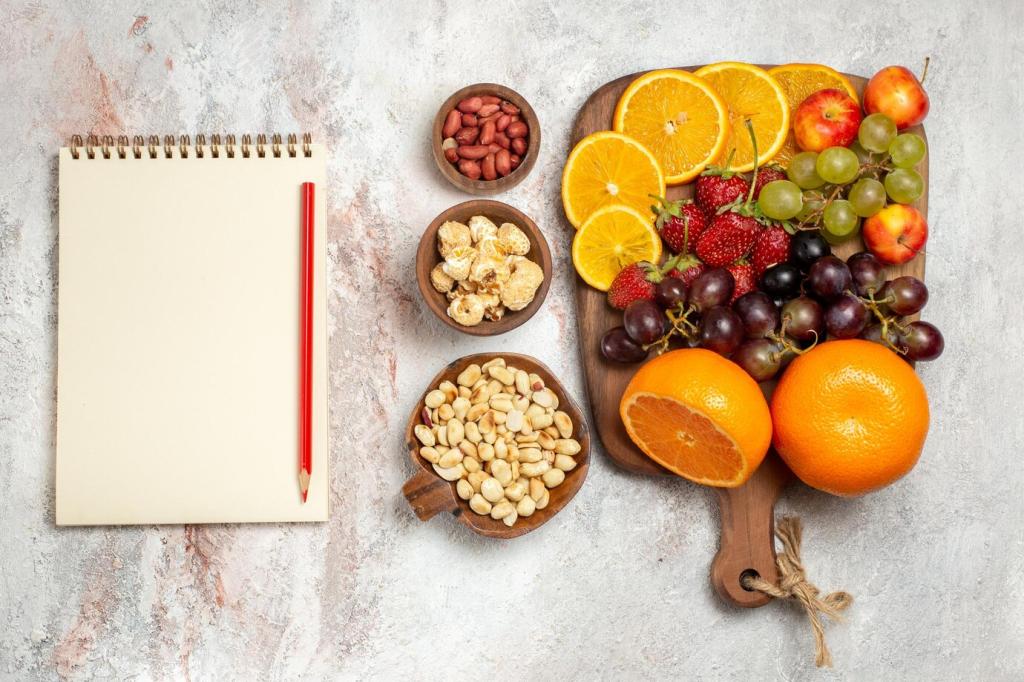Fuel Your Performance: Essential Nutrients for Athlete Meal Plans
Macronutrient Foundations for Peak Performance
Carbohydrates: The Primary Fuel
Carbohydrates power high-intensity work by replenishing muscle and liver glycogen. Emphasize whole grains, fruit, and starchy vegetables around key sessions. Many cyclists periodize carbs—bigger bowls before intervals, lighter plates on recovery days. What carb strategy keeps your legs snappy during hard efforts?
Protein: Repair, Rebuild, Adapt
Athletes thrive on consistent protein, ideally twenty to forty grams per meal with roughly two to three grams of leucine. Mix lean meats, dairy, soy, or blended plant sources to cover amino acids. Share your favorite recovery meal and tell us how it helps you bounce back stronger after demanding workouts.
Fats: Endurance, Hormones, and Absorption
Healthy fats support long sessions, hormones, and absorption of vitamins A, D, E, and K. Choose olive oil, nuts, seeds, and fatty fish for omega-3s that tame inflammation. Comment below if adding avocado or salmon has helped you sustain energy during long training or improved post-session recovery.


Low iron quietly erodes performance by diminishing oxygen transport. Combine iron-rich foods with vitamin C and monitor ferritin if fatigue lingers. A mid-distance runner regained tempo pace after pairing lentils with citrus and scheduling tea away from meals. Have you checked your iron status during heavy training blocks?

Your skeleton is training, too. Aim for adequate calcium and maintain vitamin D to support bone remodeling and muscle function. Dairy, fortified alternatives, leafy greens, sunlight, and small fish help. Drop a comment if strengthening your bone nutrition reduced stress reactions or kept your stride feeling resilient.

Sodium, potassium, and magnesium keep nerves firing and muscles contracting smoothly. Heavy sweaters may require more sodium, especially in heat. A tennis player ended late-match cramps by salting meals and sipping electrolyte drinks. What sweat-loss surprises have you found, and how do you replace what the session demands?
Hydration and Electrolyte Strategy
Weigh before and after a representative workout to estimate sweat loss, remembering that one kilogram change is roughly one liter. Track conditions and pace so your plan adapts. Share your numbers and let’s compare strategies for hot, humid days versus crisp, cool mornings to keep performance stable.
Nutrient Timing: Before, During, After
In the one to four hours before big sessions, aim for digestible carbohydrates with modest protein and minimal fiber or fat. Toast with banana, yogurt with honey, or rice bowls work well. Share your go-to pre-workout meal and how it keeps energy steady without stomach issues when training intensity rises.
Nutrient Timing: Before, During, After
Extended efforts benefit from thirty to ninety grams of carbohydrate per hour, often combining glucose and fructose for higher absorption. Practice fueling so your gut adapts to race-day needs. Tell us what gels, chews, or real-food options sit best for you when essential nutrients must arrive mid-effort.


Build Complete Protein Patterns
Leverage soy foods, plus complementary combos like beans and rice or hummus and whole-grain pitas. Seek leucine-rich options and distribute protein across meals. If you lifted stronger after refining your plant proteins, tell us which dishes helped you hit targets without sacrificing flavor or post-workout satisfaction.
B12, Iron, and Zinc Without Compromise
B12 usually requires fortified foods or supplements for plant-based athletes. Enhance iron and zinc availability by soaking, sprouting, and pairing with vitamin C while spacing coffee or tea. Share your lab-tested wins and how you keep essential nutrients covered during peak training and heavy competition stretches.
Omega-3s: From Seeds to Algae
Chia, flax, and walnuts provide ALA, while algae oil supplies direct EPA and DHA. These fats support recovery and cognition, valuable during intense blocks. Comment if adding algae oil or ground flax changed your soreness, sleep quality, or focus in crucial sessions across a demanding training season.



Supplements: Filling Gaps, Not Replacing Food
Creatine monohydrate, caffeine, and beta-alanine show strong support for many athletes, while nitrate-rich beet strategies can aid endurance. Always align doses with goals and timing. Share what you have trialed, and whether your metrics—from splits to bar velocity—actually improved in a measurable, repeatable way.
Supplements: Filling Gaps, Not Replacing Food
Choose third-party tested products to avoid contamination and dosing surprises. Review ingredients, check interactions, and keep a supplement log. A sprinter once lost a season to a mislabeled product; do not repeat that story. Comment if certification labels changed your purchasing confidence and routine supplement choices.


Real Stories, Real Lessons
A distance runner stalled despite perfect pacing. Low ferritin was the culprit. With iron-focused meals and smart tea timing, tempos felt lighter within weeks. She now checks labs each season. Share your story if dialing micronutrients turned confusing fatigue into confidence and consistent strength across demanding workouts.


Real Stories, Real Lessons
A year of calf cramps vanished when Leo matched sodium to his sweat rate and practiced fueling at race pace. He finished smiling instead of staggering. Tell us what hydration tweaks helped you hold form deep into efforts where essential nutrients truly decide outcomes under mounting physiological stress.
